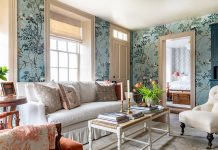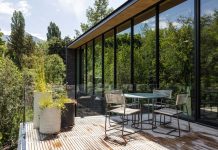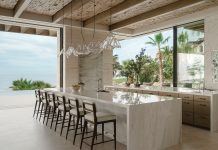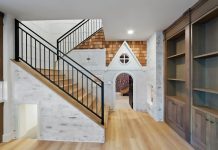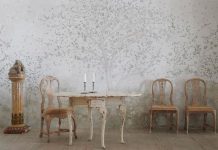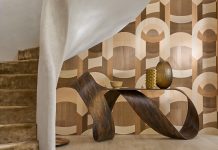Written by: Brad Mee | Photos by: Scot Zimmerman

We all have a personal style,” says architectural designer Robert McArthur, who describes his own as eclectic. “I love to collect memories and surround myself with them.” In his Bountiful home—one of three unique, semi-attached residences he designed and created for himself and clients who wanted to live in downtown Bountiful—he infused the architecture and interiors with a mix of old and new. “I wanted to create the character and energy of an older home that has been added onto over time,” he explains. Inside and out, he blended styles and periods—from European to craftsman and mid-century modern—and stirred in imaginative treatments and unexpected details across the board. “There should always be surprises,” he says. McArthur opened the doors to his unique home and shared 10 you-can-do-it-too ways to adding character and personal style to any décor.
1 Start at the Beginning
“Vestibules are the perfect place to start telling a home’s story,” says McArthur. To provide clues about the highly detailed, personalized décor that guests discover as they venture further into his home, McArthur anchored the home’s cozy entry with traditional panelling, wallpaper and furniture, then added a colorful still-life painting framed in an unexpected contemporary frame.
2. Take it Outside

“Outdoor living is very important, so create opportunities to experience and enjoy your yard and gardens,” McArthur suggests. He created inviting patios beside and behind his house and took full advantage of his small front yard by pairing two benches that frame a sitting spot along the main sidewalk. He also designed an upstairs deck on the front of the house, recessing it and the front door entry to create a sense of privacy and architectural dimension with each. A hand-painted house number and tile accents give the front entry undeniable charm.
3. Inspire Curiosity

Display unique and meaningful keepsakes to emphasize your personal style. McArthur created a “working station” niche for his great-grandmother’s functioning phone. “Personal pieces explain who you are and what you like. Why not showcase them?” he says.
4. Work the Walls (and Ceiling)

Big surfaces provide big opportunities to create statements of style. In his handsome family room furnished with original Stickley pieces, McArthur included an open-rafter ceiling that helps create the illusion that the room was added to the back of the original house over time. Dark paint visually lowers the overhead surface, helping to make the space cozier. Brick repurposed from the site’s original house forms the family room’s end wall and copper tiles clad the fireplace.
5. Be Cheeky

“Whimsy softens things and makes a home more comfortable,” McArthur says. It can also foster conversation. On the main level of his home, he numbered the window blinds, and upstairs, he lettered them. “It is a playful twist on how windows were tagged and identified during an old home’s remodeling so that they would be returned their original positions,” he says. Other surprises include a coffee-table base made from bicycle tires, a collection of birdhouses in the garden and a large mobile hanging in the upstairs loft.
6. Dish Up Some Drama

If there were ever a space ideally suited for a heavy dose of decorating, it’s the powder room. “I wanted mine to feel special and dramatic,” says McArthur of the tiny but memorable room. Large-patterned metallic wallpaper, copper tiles and an ornately framed painting of an unknown chap that McArthur’s mother refers to as “Uncle John” starkly contrast with the room’s contemporary sink, wall-mount faucet and streamlined vanity.
7. Create Architectural Interest

Most people assume that if a room doesn’t have architectural interest, they have to do without. Not McArthur. In his kitchen, for example, he masterfully united and transformed a pair of doors and side windows by framing them with molding and crowning them with a ceiling-high pediment. “I wanted to increase their height factor without using tall, 8-foot doors that would be out of place in the room,” he says. Dark green-brown paint accentuates the treatment and its visual importance in the kitchen.
8. Play with Pattern

To create a focal point in the kitchen, McArthur backed the end-of-the-room range and hood with boldly patterned tile. “The tiled wall visually creates a stopping point, adds weight and creates the illusion that the long room is shorter, making it feel wider and larger,” he explains. Large-scale gingham check enlivens the room’s roman shades and a mini-print wallpaper covers the ceiling. “Papering the ceiling harkens back to the Arts and Crafts era,” McArthur says.
9. Build on Black and White

The architecture of a house should read as sculpture and stand alone without furnishings,” McArthur explains. To accentuate the elements of his interior architecture, the designer enlisted a classic interior palette of black and white. “Black and white creates a contrasting backdrop for my furniture and artwork,” McArthur explains. Adding depth and dimension, this palette flows throughout the house, helping to create continuity from room to room.
10. Create Collections

Prized possessions go unnoticed when displayed individually around the house. There is power in numbers. By gathering multiple pieces into a single, eye-catching group, you can create a focal point while avoiding the cluttered and chaotic look of individual objects scattered about. On his stairway, McArthur created a gallery wall by grouping small art pieces and arranging them into a tightly arranged collection. Complementary framing decoratively unites the strategically positioned individual pieces. “The gallery follows the stairs, enabling close inspection of each piece,” McArthur explains.


